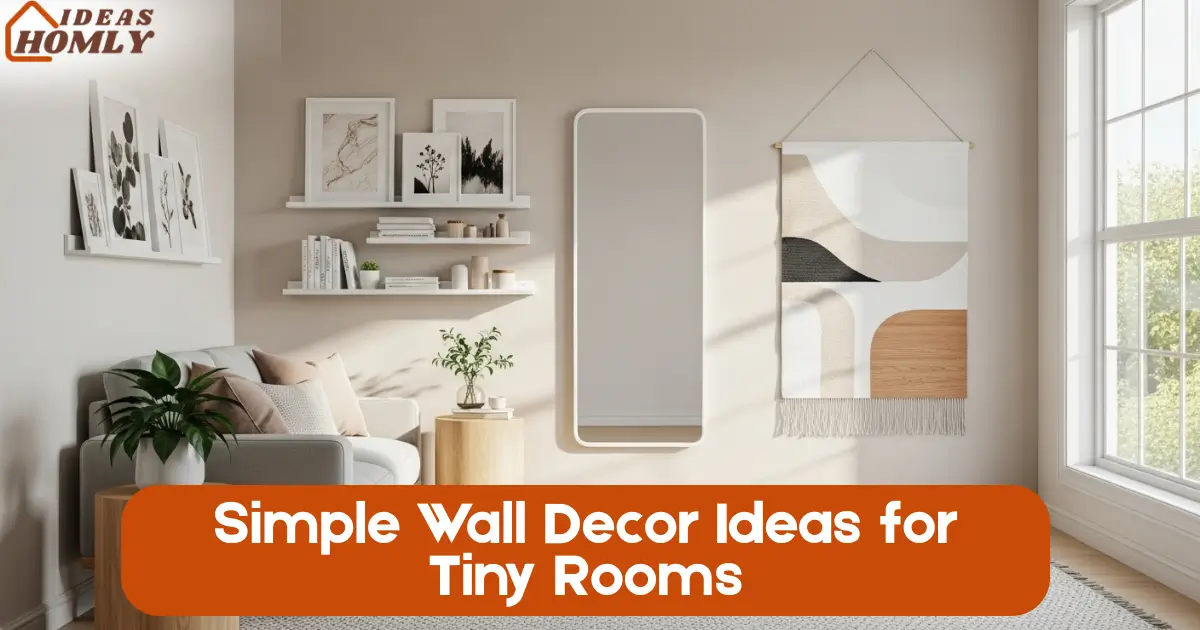Small rooms can feel even smaller when the walls are left bare. I’ve learned that the right wall decor can make a compact space feel more open, stylish, and inviting.
It’s not just about filling empty spots, but about adding personality without eating up precious floor space.
Over the years, I’ve tested countless ideas in my own home and for friends, and I’ve found a handful of approaches that work beautifully for tight spaces.
In this article, I’m sharing my favorite wall decor ideas for tiny rooms, starting with flexible, space-smart solutions you can easily adapt.
1. Picture Ledges for Flexible Art Display
Picture ledges are one of my go-to tricks for small walls because they let me change the look of a room whenever I want.
Instead of committing to a single framed piece, I can layer multiple frames and switch them out for a fresh vibe. The best part is that I don’t have to hammer new holes every time I change my mind.
I usually keep them low-profile and paint them in the same color as the wall for a seamless effect. This way, the ledge blends in and the artwork stands out.
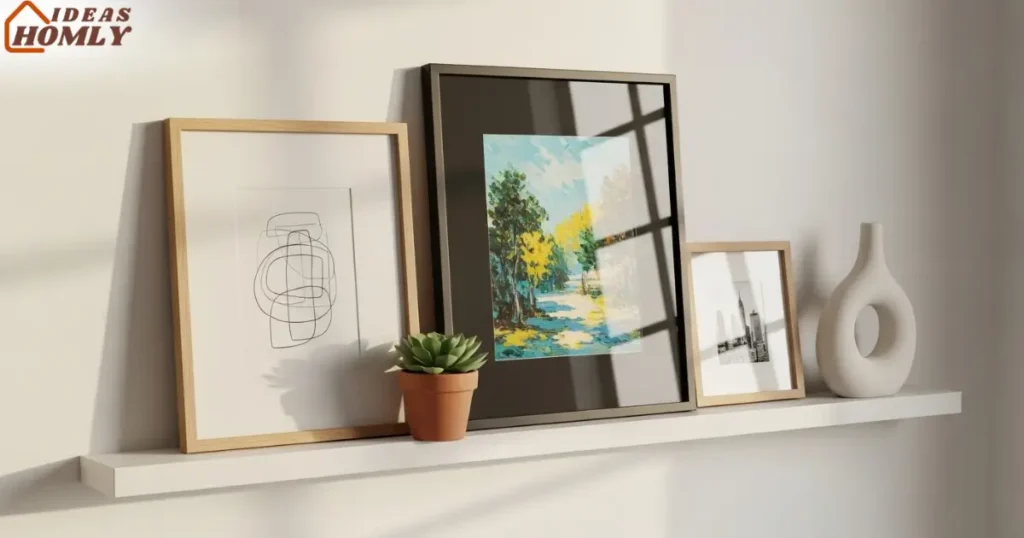
A narrow picture ledge above a desk or bed can instantly turn into a rotating mini-gallery. For added depth, I sometimes mix in small decorative objects like mini plants or sculptural items.
If you’re renting, this is also a smart solution because you can mount the ledge once and avoid a dozen nail holes. I’ve even seen people attach them with strong, removable wall strips for a completely damage-free setup.
2. Leaned Art and Mirrors for Depth
I’ll admit, I was skeptical about leaning art against the wall instead of hanging it. But in a tiny room, it can be a game-changer. Large mirrors or oversized frames leaned on a console table or dresser create depth without making the wall look crowded.
One of my favorite setups is placing a tall mirror in a corner where it reflects light from a window. It not only makes the room look bigger, but also adds an airy feel. When I use leaned artwork, I like to overlap different sizes for a casual, layered look.

The bonus is that there’s no commitment. If you like rearranging furniture or changing decor seasonally, leaned pieces are easy to move around. Plus, it saves you from drilling holes in tricky spots like brick or plaster.
3. Slim Floating Shelves for Books and Greens
Slim floating shelves are perfect for small rooms because they add vertical storage without eating into floor space. I’ve installed them above door frames, between windows, and even in narrow wall gaps where nothing else would fit.
In my reading nook, I use a pair of slim white shelves to hold small plants, a stack of paperbacks, and a candle or two. It creates a cozy, layered look while keeping surfaces like nightstands and desks clutter-free.
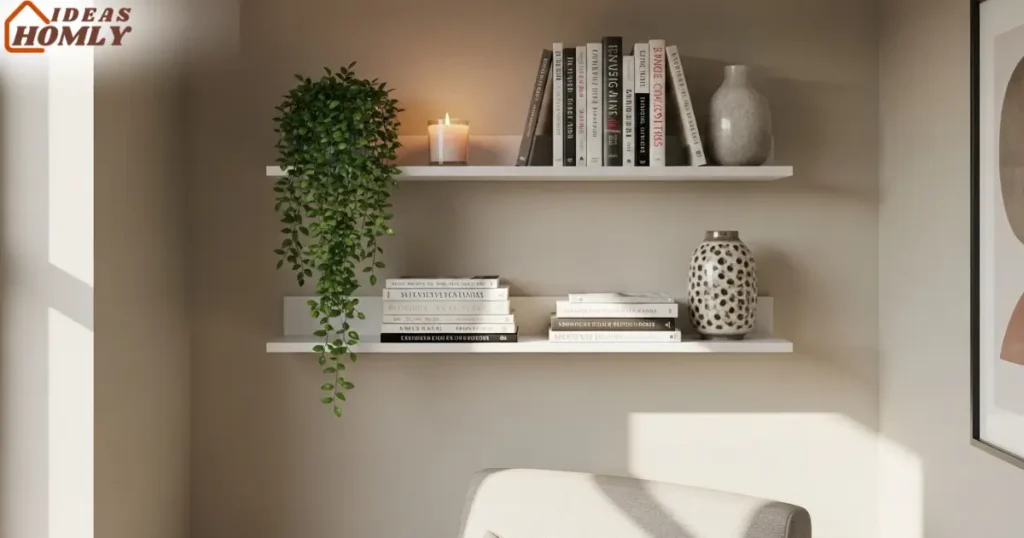
I recommend choosing shelves with a depth of no more than 4-6 inches so they don’t protrude too much.
Matching the shelf color to your wall keeps things light and airy. If you want to make it feel more styled, group objects in odd numbers and vary their heights for visual balance.
4. Over-Bed Decor Ideas
The wall above the bed is often the biggest blank canvas in a small bedroom, and I never like to waste it.
I’ve found that the key is choosing decor that adds interest without feeling heavy or overwhelming. A single large framed print works beautifully if you want a clean and balanced look.
For a more layered style, I sometimes hang two or three smaller pieces in a straight line or a gentle offset. This adds personality while keeping the visual weight even across the wall.
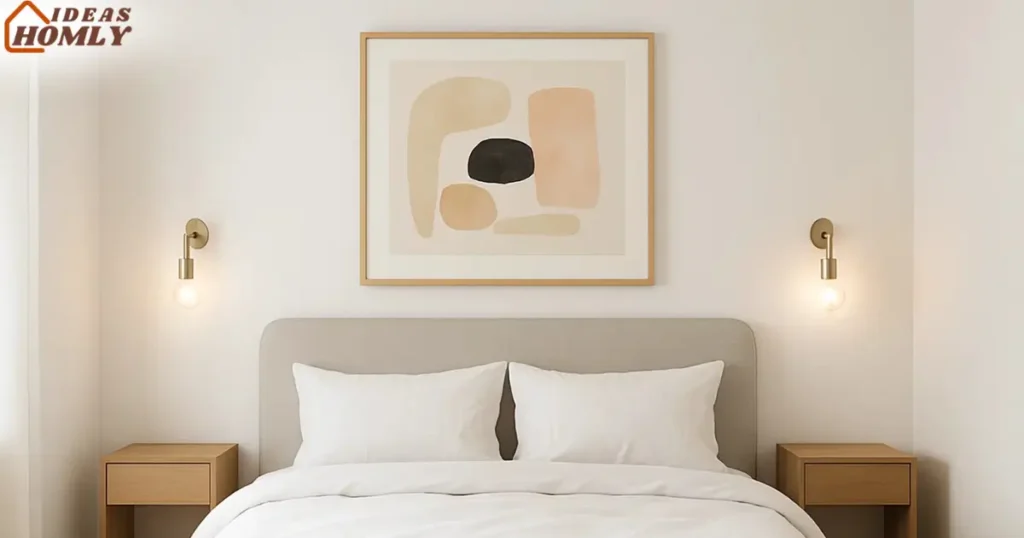
Another favorite trick of mine is a soft, fabric-covered headboard that extends up the wall, and it creates comfort and acts as decor at the same time.
I also love using slim wall-mounted sconces in place of table lamps above the bed. They free up nightstand space and draw the eye upward.
Just be sure to position them at a height where they provide good reading light without shining directly into your eyes.
5. Lightweight Textiles on Walls
Hanging textiles is one of my easiest and most budget-friendly ways to fill a wall in a tiny room. I’ve used everything from woven tapestries to lightweight linen panels, and they instantly add warmth and texture.
I like them because they don’t require heavy-duty mounting, just a small rod, dowel, or even decorative hooks.
In small rooms, I stick to lighter fabrics in airy colors so the wall doesn’t feel closed in. Large-scale macrame, simple woven cloths, or patterned throws all work well here.
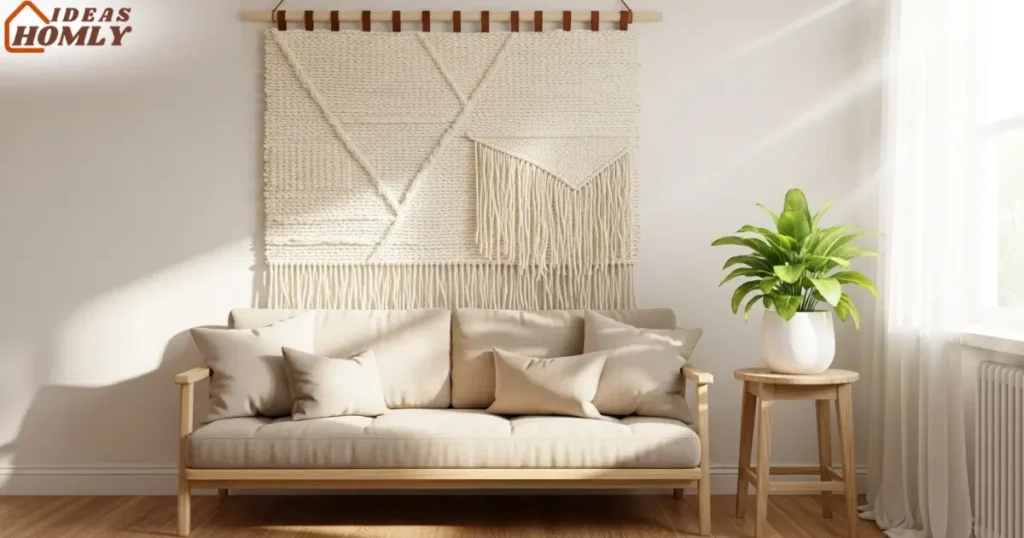
The bonus is how versatile they are. I can swap them seasonally, fold them away when I want a cleaner look, or layer them over a mirror for extra softness.
And if you rent, this is a damage-free way to get a big visual impact without permanent changes.
6. Peel-and-Stick Murals for Renters
Peel-and-stick murals are perfect when you want a bold statement but can’t commit to permanent wallpaper. I’ve used them to add depth to small living rooms and cozy corners, and the difference is instant.
Because they’re removable, I can experiment with patterns or colors I wouldn’t normally risk. For example, a botanical mural behind a reading chair or a subtle geometric print behind a desk can change the mood of the whole space.
I always measure the wall carefully before ordering and choose a design that complements, not competes with, the room’s other decor.
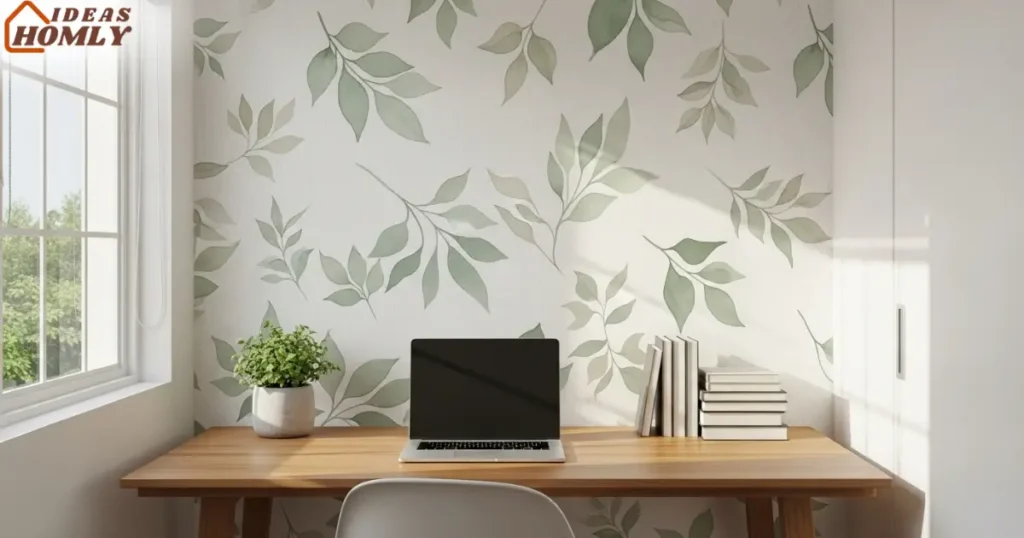
Lighter backgrounds with soft patterns help small rooms feel bigger, while darker prints can create a dramatic, cocoon-like vibe if that’s your style.
Mistakes to Avoid in Small Room Wall Decor
Through trial and error, I’ve learned that small rooms require a careful balance when decorating walls. Here are the big mistakes I always avoid:
- Crowding the wall: Too many pieces make the room feel busy and smaller than it is.
- Using oversized furniture against decorated walls: It blocks the view and defeats the purpose.
- Ignoring vertical space: Tall arrangements can draw the eye upward, making the room feel bigger.
- Choosing dark, heavy frames for light walls: It adds unnecessary weight unless you’re going for high contrast.
- Not planning for scale: Tiny art on a big wall or giant frames on a small wall can throw off proportions.
I’ve made every one of these mistakes at some point, and fixing them instantly improved the flow and feel of my space.
Quick Comparison of the Six Ideas
| Wall Decor Idea | Best For | Pros | Considerations |
|---|---|---|---|
| Picture Ledges | Flexible art display | Easy to swap, renter-friendly | Needs occasional dusting |
| Leaned Art & Mirrors | Adding depth & reflection | No drilling, easy to move | Requires stable base surface |
| Slim Floating Shelves | Storage & greenery | Saves floor space, versatile | Avoid overloading with heavy items |
| Over-Bed Decor | Bedroom focal point | Utilizes unused wall space | Keep proportions balanced |
| Lightweight Textiles | Soft texture & warmth | Easy to hang & change | Avoid overly heavy fabrics |
| Peel-and-Stick Murals | Bold statement without commitment | Removable, wide design range | Measure carefully before buying |
Conclusion
After years of decorating small spaces, I’ve realized that wall decor is less about filling gaps and more about creating balance, personality, and function.
The six ideas I’ve shared – picture ledges, leaned art and mirrors, slim floating shelves, over-bed arrangements, lightweight textiles, and peel-and-stick murals have all worked wonders in my own tiny rooms.
They bring in style without sacrificing space, and most of them can be changed or updated as often as you like.
If you’re working with a small room, focus on adaptable, lightweight, and visually balanced solutions.
Keep the color palette consistent, use vertical space smartly, and avoid overcrowding. These little tweaks can make a room feel bigger, brighter, and far more inviting.
FAQs
I keep the number of pieces minimal and arrange them with breathing space between each. Using a consistent frame style or color palette also helps create a cohesive look. This way, the wall feels intentional, not crowded.
Yes, as long as the scale is right. I often use one large piece instead of several small ones, which keeps the look clean and makes a bigger impact without overwhelming the space.
For me, peel-and-stick murals and lightweight textiles win. They’re affordable, easy to install, and removable without leaving damage. Picture ledges are another renter-friendly choice since you mount them once and swap out the art anytime.
Absolutely. I’ve placed mirrors across from windows and watched the light bounce around, instantly opening up the space. Leaned or wall-mounted mirrors also add depth without adding bulk.
I start by looking at the tones in my furniture and accessories. Neutral walls are the safest for flexibility, while muted pastels or soft earthy shades can add personality without overpowering a small room.

